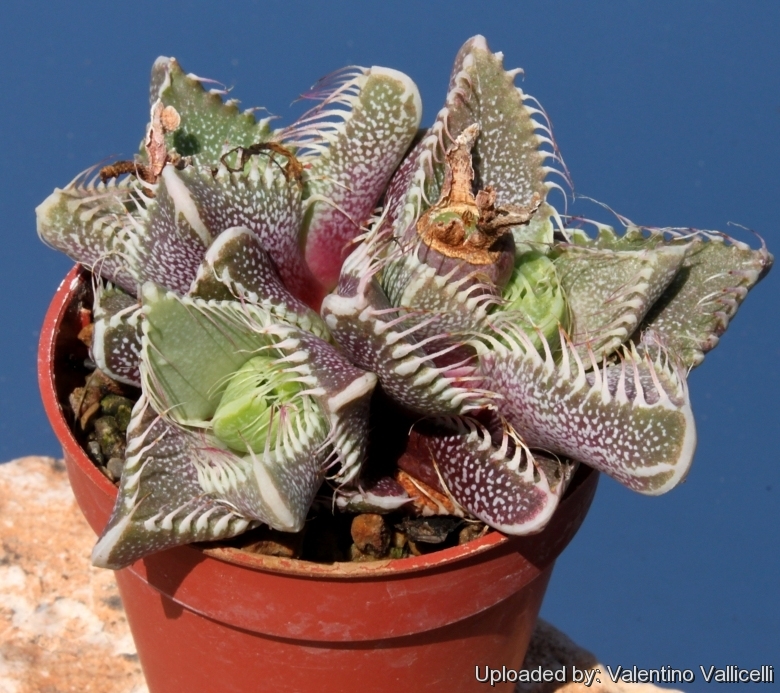
Faucaria tigrina Photo by: Valentino Vallicelli
(Locality Grahamston) are very handsome plants with soft white teeth along the edges. They look like little alligator jaws. In the garden they slowly sucker growing in a circle larger and larger until they come up upon another plant making a unique carpet of plant completely covering the ground.
Origin and Habitat: Faucaria tigrinaSN|14721]]SN|14721]] is narrow endemic at the edge of Grahamstown, Eastern Cape Province, South Africa. Extent of occurrence less than 200 km², four known locations remain after many subpopulations declined due to urban expansion around Grahamstown. Subpopulations are small, fragmented and continue to decline.
Altitude range: 550 - 920 metres above sea level.
Habitat and ecology: This species grows in mountain renosterveld in Albany Thicket, Savanna on open sandstone patches in a dark clayish soil with a low pH (pH 4.7-5.7). The many white-coloured flecks on the often reddish leaves resemble the lichens and reddish rocks in its natural surroundings. Rainfall around 680 mm per annum (Grahamstown). This species continues to decline because of cultivation, overgrazing and urbanisation.
Synonyms:
See all synonyms of Faucaria tigrina
back
Accepted name in llifle Database:Faucaria tigrina (Haw.) SchwantesZ. Sukkulentenk. ii. 177 (1926).Synonymy: 4
back
Common Names include:
ENGLISH: Shark's Jaws, Tiger Jaws
Description: Faucaria tigrinaSN|16572]]SN|14721]] is a compact clump-forming succulent perennial, rosette, usually stemless (but can builds short woody stems with age). The species was discovered as early as 1790 (Bolus 1927), probably because of its accessibility. Faucaria tigrinaSN|16572]]SN|14721]] is a compact, crowded and distinctly flecked plant having 9-10 teeth with long bristles on the short leaves.
Leaves: Thick, 30-40(-50) mm long, 15-20(-25) mm,broad, very crowded, pressed against each other, more or less erect, green to grey-green, turning to bluish purple, triangular to ovate-rhomboid in upper half lowest half of leaves square, sharply keeled at top and toothed. Margins and keel whitish. Teeth (5-)9-10(-12) along each edge, with soft translucent slightly recurved backwards bristles, making them look like open jaws. Epidermis slightly rough with a profusion of white dots upon close inspection and with a rounded interface, confluent into larger flecks, often arranged in curved lines towards keel, minute white dots absent.
Flowers: Numerous, silky yellow, up to 5 cm wide, attractive daisy like, appearing from the centre of the rosette. Petals 100-120, linear, acute, 1-1.25 mm wide. Stamens 250-300. Nectar glands brownish, surface often 3-ribbed.
Fruits: Bell-shaped 7-9.5 long, 8-10(-12) broad and (6-8-9 mm thick coming loose rather easily, top of fruit flattened to slightly spherical. Fruit stalk absent or 0.5-3.8 mm long, 3-4 mm broad and 0.9-1.6 mm thick.
Seeds: 1.15-1.5 long 1-1.25 mm broad.
Blooming season: Autumn to early winter (March—May). They need full sun to open, open around noon and close at night.
Note: Faucaria tigrinaSN|16572]]SN|14721]] clumps more than the plants in the Faucaria felinaSN|14721]]SN|16572]] group and has often a reddish tinge and a higher number of teeth (which are long and bristly). The more conspicuous spotting also separates this species from Faucaria felinaSN|14721]]SN|16572]], which has less erect leaves. However some populations of Faucaria felinaSN|14721]]SN|16572]] subsp. britteniae at Hell's Poort, 35 km west of Grahamstown and near Fort Beaufort. look like F. tigrina because of the numerous large flecks on the leaves and the long bristles. Yet, the leaves of F. felina subsp. britteniae are larger, not pressed against each other and the number of teeth is reduced to 5 or 6. Forma splendens published by Jacobsen & Rowley in 1955. was recognised on the basis of its reddish leaves typical for some populations. F. tigrina 'Superba' is a superfluous synonym. used in seed catalogues to differentiate good plants and seed, reintroduced by Mrs Dudley Ryder from the usually inferior hybrids named F tigrina (Weber 1968).
They all share a rough upper surface. The shape of the leaf varies from long to short triangular. The name felina refers to the likeness of the leaves to the claws of a cat. The recurved leaf tubercles have very broad bases and look like cat's nails rather than teeth!
Subspecies, varieties, forms and cultivars of plants belonging to the Faucaria tigrina group
Notes: Faucaria tigrinaSN|14721]]SN|14721]] is a variable taxon that now comprises many Faucaria’s form previously considered independent the species. The several species of this South African genus of succulents are so similar that many may be hybrids.
Bibliography: Major references and further lectures
1) Heidrun E. K. Hartmann “Aizoaceae F – Z” Springer, 2002
2) James Cullen, Sabina G. Knees, H. Suzanne Cubey “The European Garden Flora Flowering Plants: A Manual for the Identification of Plants Cultivated in Europe, Both Out-of-Doors and Under Glass - Casuarinaceae to Aristolochiaceae” Cambridge University Press, 11/ago/2011
3) Hermann Jacobsen, Vera Higgins “Succulent Plants: Description, Cultivation and Uses of Succulent Plants, Other Than Cacti” Williams and Norgate, Limited, 1935
4) Jacobsen. “Handbook of succulent plants” 1328 (1960)
5) H. Herre “The genera of the Mesembryanthemaceae” Tafelberg-Uitgewers Beperk, 1971
6) L. E. Groen, L. J. G. van der Maesen “Revision of the genus Faucaria (Ruschioideae: Aizoaceae) in South Africa” Bothalia 29: 35-58, 1999.
7) Doreen Court “Succulent Flora of Southern Africa” CRC Press, 01 June 2000
8) Ernst Van Jaarsveld, Ben-Erik Van Wyk, Gideon Smith “Succulents of South Africa: A Guide to the Regional Diversity” Tafelberg, 2000
9) African Plants Database (version 3.4.0). Conservatoire et Jardin botaniques de la Ville de Genève and South African National Biodiversity Institute, Pretoria, "Retrieved [8 November 2015]", from <http://www.ville-ge.ch/musinfo/bd/cjb/africa/>.
10) Victor, J.E. & Dold, A.P. 2007. Faucaria tigrina (Haw.) Schwantes. National Assessment: Red List of South African Plants version 2015.1. Accessed on 2015/11/09
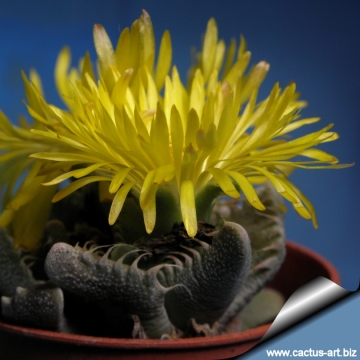 Faucaria tigrina Photo by: Cactus Art
Faucaria tigrina Photo by: Cactus Art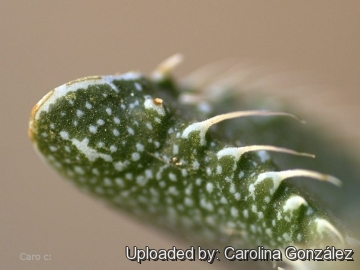 Faucaria tigrina Photo by: Carolina González
Faucaria tigrina Photo by: Carolina González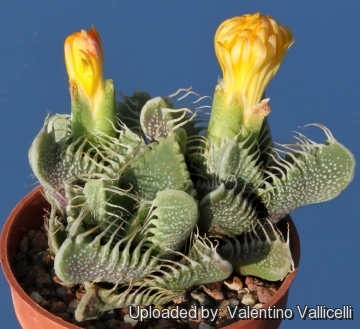 Faucaria tigrina Photo by: Valentino Vallicelli
Faucaria tigrina Photo by: Valentino Vallicelli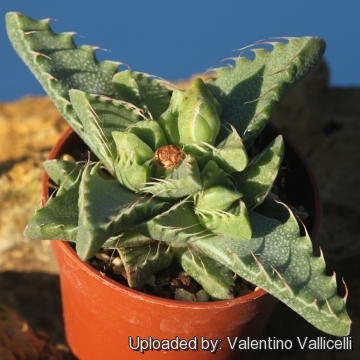 Faucaria aff. tigrina W. Fort Brown. Photo by: Valentino Vallicelli
Faucaria aff. tigrina W. Fort Brown. Photo by: Valentino Vallicelli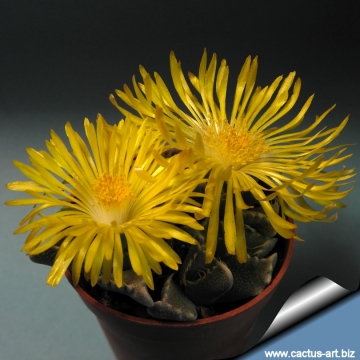 Faucaria tigrina Photo by: Cactus Art
Faucaria tigrina Photo by: Cactus Art Faucaria tigrina Photo by: Cactus Art
Faucaria tigrina Photo by: Cactus Art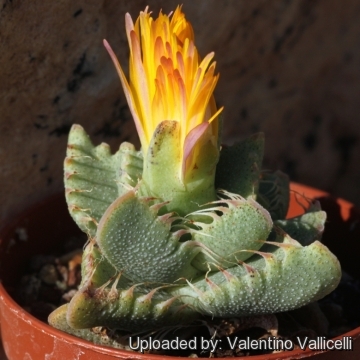 Fort Brown Photo by: Valentino Vallicelli
Fort Brown Photo by: Valentino Vallicelli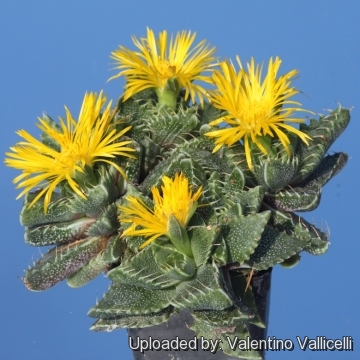 Faucaria tigrina Photo by: Valentino Vallicelli
Faucaria tigrina Photo by: Valentino VallicelliCultivation and Propagation: The plants in this genus represent some of the more easily cultivated succulent species ; These plants grow on winter rain and were heading for spring-summer dormancy. Requires little water otherwise their epidermis breaks (resulting in unsightly scars). Water moderately from the middle of summer to the end of winter, and keep the compost almost dry when the plants are dormant. Water minimally in spring and summer, only when the plant starts shrivelling (, but they will generally grow even in summer if given water) In areas prone to frost, grow in an intermediate greenhouse or conservatory, in pots of cactus compost, obtainable from good garden centres. Keep cool and shaded in summer, but provide maximum light the rest of the year.
Propagation: Seeds or division of larger clumps.
Your Photos
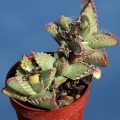
by Valentino Vallicelli
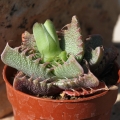
by Valentino Vallicelli
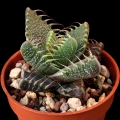
by Valentino Vallicelli
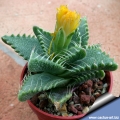
by Cactus Art
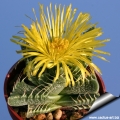
by Cactus Art























